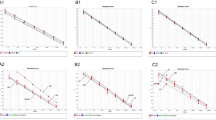Abstract
In order to meet the need of many microbiological laboratories for a standardized system for detecting Chlamydia pneumoniae in respiratory specimens, a hybridization probe-based LightCycler (Roche Diagnostics, Germany) PCR assay was developed. The assay's analytical sensitivity and specificity were evaluated according to the recommendations of the Centers for Disease Control and Prevention (USA) and Laboratory Centre for Disease Control (Canada). Seventy-four bacterial species other than Chlamydia pneumoniae, including strains of Chlamydia trachomatis, Chlamydia psittaci, and Chlamydia pecorum, tested negative. Six of six representative Chlamydia pneumoniae strains tested positive. An analytical sensitivity of 1 inclusion forming unit per ml of bronchoalveolar lavage fluid, corresponding to 0.02 inclusion forming units per PCR reaction, was observed. The assay showed 100% specificity and sensitivity for Chlamydia pneumoniae when testing DNA preparations from 12 specimens of patients with known pulmonary Chlamydia pneumoniae infection and from 78 specimens of patients with respiratory tract disease of other origin. The newly developed LightCycler assay may contribute to the urgently needed standardization of laboratory diagnosis of Chlamydia pneumoniae.


Similar content being viewed by others
References
Campbell LA, Melgosa MP, Hamilton DJ, Kuo CC, Grayston JT (1992) Detection ofChlamydia pneumoniae by polymerase chain reaction. J Clin Microbiol 30:434–439
Gaydos CA, Quinn TC, Eiden JJ (1992) Identification ofChlamydia pneumoniae by DNA amplification of the 16S rRNA gene. J Clin Microbiol 30:796–800
Apfalter P, Blasi F, Boman J, Gaydos CA, Kundi M, Maass M, Makristathis A, Meijer A, Nadrchal R, Persson K, Rotter ML, Tong CY, Stanek G, Hirschl AM (2001) Multicenter comparison trial of DNA extraction methods and PCR assays for detection ofChlamydia pneumoniae in endarterectomy specimens. J Clin Microbiol 39:519–524
Dowell SF, Peeling RW, Boman J, Carlone GM, Fields BS, Guarner J, Hammerschlag MR, Jackson LA, Kuo CC, Maass M, Messmer TO, Talkington DF, Tondella ML, Zaki SR (2001) StandardizingChlamydia pneumoniae assays: recommendations from the Centers for Disease Control and Prevention (USA) and the Laboratory Centre for Disease Control (Canada). Clin Infect Dis 33:492–503
Tompkins LS, Schachter J, Boman J, Chernesky MA, Dowell S, Gaydos CA, Levison ME, Maass M, Madico G, Orfila J, Ouchi K, Peeling RW, Taylor-Robinson D, Stamm WE, Wang SP, Blasi F, Relman D (2000) Collaborative multidisciplinary workshop report: detection, culture, serology, and antimicrobial susceptibility testing ofChlamydia pneumoniae. J Infect Dis 181 (Suppl 3):460–461
Jantos CA, Roggendorf R, Wuppermann FN, Hegemann JH (1998) Rapid detection ofChlamydia pneumoniae by PCR-enzyme immunoassay. J Clin Microbiol 36:1890–1894
Essig A, Zucs P, Susa M, Wasenauer G, Mamat U, Hetzel M, Vogel U, Wieshammer S, Brade H, Marre R (1995) Diagnosis of ornithosis by cell culture and polymerase chain reaction in a patient with chronic pneumonia. Clin Infect Dis 21:1495–1497
Boman J, Allard A, Persson K, Lundborg M, Juto P, Wadell G (1997) Rapid diagnosis of respiratoryChlamydia pneumoniae infection by nested touchdown polymerase chain reaction compared with culture and antigen detection by EIA. J Infect Dis 175:1523–1526
Tong CY, Sillis M (1993) Detection ofChlamydia pneumoniae and Chlamydia psittaci in sputum samples by PCR. J Clin Pathol 46:313–317
Essig A, Simnacher U, Susa M, Marre R (1999) Analysis of the humoral immune response toChlamydia pneumoniae by immunoblotting and immunoprecipitation. Clin Diagn Lab Immunol 6:819–825
Reischl U, Leppmeier B, DaCosta C, Miethke T, Lehn N (2000) Comparison of MagNAPure LC, High Pure PCR Template Preparation Kit, and phenol/choloroform for the extraction of total genomic DNA fromChlamydia pneumoniae-infected Hep-2 cells. Biochemica 3:9–12
Roche Molecular Biochemicals (2000) Absolute quantification with external standards. Technical Note LC 11/2000. Roche Diagnostics, Mannheim, Germany, pp 1–18
Shirai M, Hirakawa H, Kimoto M, Tabuchi M, Kishi F, Ouchi K, Shiba T, Ishii K, Hattori M, Kuhara S, Nakazawa T (2000) Comparison of whole genome sequences ofChlamydia pneumoniae J138 from Japan and CWL029 from USA. Nucl Acids Res 28:2311–2314
Tondella MLC, Talkington DF, Holloway BP, Dowell SF, Cowley K, Soriano-Gabarro M, Elkind MS, Fields BS (2002) Development and evaluation of a real-time PCR-based fluoresecence assay for detection ofChlamydia pneumoniae. J Clin Microbiol 40:575–588
Kalman S, Mitchell W, Marathe R, Lammel C, Fan J, Hyman RW, Olinger L, Grimwood J, Davis RW, Stephens RS (1999) Comparative genomes ofChlamydia pneumoniae and C. trachomatis. Nature Genet 21:385–389
Acknowledgements
The authors would like to thank K. Barratt and J. Emch for their active support and gratefully acknowledge the excellent technical assistance of S. Weiß, M. Bollwein, M. Bibiana Alberdi, and M. Hien. The study was supported by grants from the Deutsche Forschungsgemeinschaft (Sonderforschungsbereich SFB 451) and the Bundesministerium für Bildung und Forschung (Kompetenznetzwerk community acquired pneumonia; CAPNETZ) to RM and AE.
Author information
Authors and Affiliations
Corresponding author
Rights and permissions
About this article
Cite this article
Reischl, U., Lehn, N., Simnacher, U. et al. Rapid and Standardized Detection of Chlamydia pneumoniae Using LightCycler Real-Time Fluorescence PCR. Eur J Clin Microbiol Infect Dis 22, 54–57 (2003). https://doi.org/10.1007/s10096-002-0858-2
Published:
Issue Date:
DOI: https://doi.org/10.1007/s10096-002-0858-2




